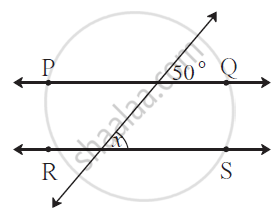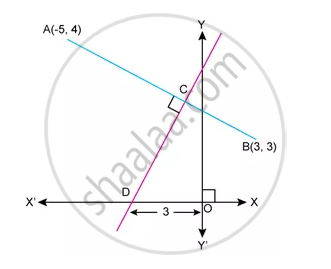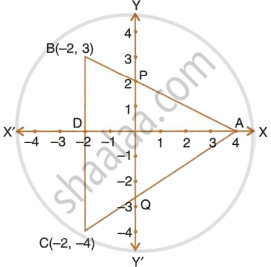Advertisements
Advertisements
Question
Find the equation of the line passing through the points (4,-5) and (-1,-2).
Solution
Equation of line passing through points (x1,y1) and (x2,y2) is given by
`(x - x_1)/(x_1 - x_2) = (y - y_1)/(y_1 - y_2)`
Here (x1,y1) = (4,-5) and (x2,y2) = (-1,-2)
Equation of line passing through (4,-5) and (-1,-2) is given by
`(x - 4)/(4 - (-1)) = (y - (-5))/((-5) - (-2))`
∴ `(x - 4)/5 = (y + 5)/-3`
∴ (-3)(x-4) = 5(y + 5)
∴ - 3x + 12 = 5y + 25
∴ 12 – 25 = 5y + 3x
∴ 3x + 5y = - 13
∴ 3x + 5y + 13 = 0
Therefore equation of line passing through (4,-5) and (-1,-2) is 3x + 5y + 13 = 0
APPEARS IN
RELATED QUESTIONS
A (5, 4), B (-3, -2) and C (1, -8) are the vertices of a triangle ABC. Find the equations of the median AD and line parallel to AC passing through the point B.
Write the equation of each of the following lines:
- The x-axis and the y-axis.
- The line passing through the origin and the point (-3, 5).
- The line passing through the point (-3, 4) and parallel to X-axis.
Find the slope and y-intercept of the line:
y = 4
Find the slope and y-intercept of the line:
3x – 4y = 5
Is the line 3x + 4y + 7 = 0 perpendicular to the line 28x – 21y + 50 = 0?
Is the line 3x + 2y = 5 parallel to the line x + 2y = 1?
Find the equation of the line passing through (−2, 1) and perpendicular to 4x + 5y = 6.
Find the equation of the perpendicular bisector of the line segment obtained on joining the points (6, −3) and (0, 3).
B(−5, 6) and D(1, 4) are the vertices of rhombus ABCD. Find the equations of diagonals BD and AC.
A = (7, −2) and C = (−1, −6) are the vertices of square ABCD. Find the equations of diagonals AC and BD.
Show that points P(2, –2), Q(7, 3), R(11, –1) and S (6, –6) are vertices of a parallelogram.
In the figure, line PQ || line RS. Using the information given
in the figure find the value of x.

Line PQ is parallel to line RS where points P,Q,R and S have
co-ordinates (2, 4), (3, 6), (3, 1) and (5, k) respectively. Find value of k.
Find Equation of CD

Find the equation of the line that has x-intercept = –3 and is perpendicular to 3x + 5y = 1.
A line through point P(4, 3) meets x-axis at point A and the y-axis at point B. If BP is double of PA, find the equation of AB.
Find the equation of line through the intersection of lines 2x – y = 1 and 3x + 2y = –9 and making an angle of 30° with positive direction of x-axis.
In the figure, given, ABC is a triangle and BC is parallel to the y-axis. AB and AC intersect the y-axis at P and Q respectively.

- Write the co-ordinates of A.
- Find the length of AB and AC.
- Find the radio in which Q divides AC.
- Find the equation of the line AC.
If (4,-3) is a point on line 5x +8y = c, find the value of c.
A line is parallel to Y-axis and is at a distance of 5 units from the Y-axis. Write the equation of that line.
